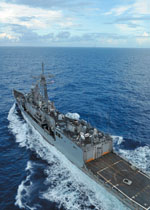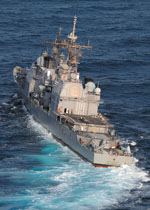Commercial Equipment Speeds Naval Communications, Replaces Aging Hardware
 |
 |
 |
| The U.S. Navy’s Commercial Broadband Satellite Program (CBSP) is replacing the fleet’s current commercial satellite communications terminals with new ones operating at higher bandwidth and throughput levels. The effort is enabling installation of three types of terminals to support large vessels such as aircraft carriers, mid-size ships such as cruisers and destroyers, and a version for small ships such as frigates. |
An advanced satellite communications terminal is boosting the connectivity of U.S. Navy warships. Part of an effort to complement vessels’ military satellite communications capabilities, the new commercial terminals are designed to increase data transmission speeds to meet the service’s growing need for network-centric applications such as live tactical imagery.
Warships increasingly rely on satellite connectivity for communications and to coordinate operations. But bandwidth is limited, and new tools such as live streaming video from unmanned platforms can stress overburdened systems. New generations of high-capacity equipment avoid legacy systems’ data bottlenecks and permit seagoing warfighters to share information and intelligence quickly and efficiently.
The Commercial Broadband Satellite Program (CBSP) is replacing the Navy’s current civilian satellite terminals with three types of terminals designed to fit in warships ranging from aircraft carriers to small coastal patrol vessels. The CBSP also is working closely with the Navy Multiband Terminal (NMT) program (SIGNAL Magazine, December 2004), which is replacing the service’s legacy military satellite communications equipment, says Kai Tang, director of the U.S. Navy’s Space and Naval Warfare Systems Command’s (SPAWAR’s) satellite communications division, San Diego, California. The programs are managed by SPAWAR’s Communications Program Office in the Navy’s Program Executive Office for Command, Control, Communications, Computers and Intelligence (PEO C4I).
Both the CBSP and the NMT are designed to allow ships to transmit voice, video and data faster and at greater volume. Tang explains that the programs are a successful application of the Navy’s satellite communications strategy because by consolidating these efforts, the service can leverage emerging technology at reduced costs. “Ultimately, the increased satellite communication capability will enhance operational effectiveness and significantly improve quality of life for sailors underway,” he claims.
The CBSP terminals will provide Navy ships with a ten-fold increase in communications throughput, Tang says. Navy ships currently use Inmarsat B HSD and Commercial Wideband SATCOM Program (CWSP) equipment. These legacy systems have throughput ranges of 64 to 128 kilobits per second for smaller ships and up to 4 megabits per second for large vessels. The CBSP terminals are capable of providing from 881 kilobits per second in the small-ship version and up to 21.4 megabits per second for larger-ship variants. The total throughput for individual ships varies depending on the amount of commercial bandwidth the Navy can lease and the amount of allocated military communications bandwidth, he says.
In September 2008, the program began installing the CBSP terminals on what the Navy terms small, bandwidth-disadvantaged ships, such as frigates, coastal patrol ships and minesweepers. Terminals for larger vessels are scheduled to become available this fall, but Tang notes that the current priority is to install equipment on smaller vessels. Under the program’s rapid deployment capability, 49 terminals initially will be placed on Navy ships. The service plans to issue an additional 200 systems to the fleet over the next few years.
The NMT is scheduled to start operating this year. A fourth-generation military satellite communications system, the NMT will provide vessels and ground installations with communications via Advanced Extremely High Frequency, Milstar, Ultra High Frequency Follow-On, Polar, Defense Satellite Communications System and Wideband Global SATCOM satellites. The terminals also will transmit protected wideband messages via the Q, Ka and X bands for ships; the Q and X bands for submarines; the Q band for shore installations; and Global Broadcast System (GBS) reception for ships and submarines. The services plan to install more than 300 NMT units.
Both programs replace several legacy terminal programs. Tang explains that the new terminals are replacing aging systems that in some cases have been in service for several decades. The CBSP replaces the Navy’s Inmarsat and CWSP programs. Likewise, the NMT consolidates the service’s military satellite communications efforts such as the Extremely High Frequency Satellite Communications, the WSC-6 Super High Frequency and the Global Broadcast Service programs into a single program.
Tang states that the consolidations are part of the Navy’s strategy to maximize military satellite communications use with commercial satellite communications support. “That would standardize and give us the ability to reduce back-end sustainment, operation, maintenance and management costs involved in running multiple programs. When we get down to just two programs, our vision is that this would significantly reduce tail-end support,” he says.
Although the NMT and the CBSP are related efforts, not all ships will have both terminals. Tang explains that some smaller ships will be equipped with the CBSP only to replace legacy Inmarsat systems. Some ships will mainly rely on the NMT and not use the CBSP except as a backup, and other ships will use both systems to provide a complete bandwidth throughput capability. However, he says that providing the Navy with this variety of terminal options is one of the program’s long-term goals. The next several years will be a transition period as the NMT and CBSP sets are installed in the fleet.
Tang emphasizes that the CBSP terminals are commercial in the sense that they contain off-the-shelf components. He explains that regardless of the type of satellite communications system, all communications are encrypted. Ships equipped with the CBSP and the NMT have protected wideband and wideband satellite communications capabilities.
The small-ship terminal operates in the Ku band. Unit-level ships, such as cruisers and destroyers, will use Ku-band communications with X-band capabilities. Tang notes that the CBSP terminals use the commercial X band, but they are also capable of using military bands. Large vessels such as command ships and aircraft carriers will be able to access satellites using the Ku and C bands.
Both the NMT and CBSP programs are designed around the concept of increased growth over their operational lives. Tang says that the CBSP and NMT equipment can be upgraded to accommodate higher data rates to meet future requirements. “These terminals are going to be here for quite a while,” he remarks.
 |
| The growing use of online education for Navy personnel, along with advanced tactical capabilities such as streaming video, have greatly increased the demand placed on shipboard satellite communications systems. The CBSP terminals can be upgraded to meet rising throughput and bandwidth demands. |
Another issue affecting throughput is the leasing of commercial satellite bandwidth and shore-based architecture. Although the Navy can provide its own shore-based infrastructure to support users in the fleet, Tang observes that commercial vendors will be held to very high standards for satellite communications service reliability and value. He adds that the Defense Information Systems Agency is supporting the Navy on this effort to provide competitive pricing.
While the CBSP program is making progress in equipping smaller ships in the fleet, Tang notes that installing the terminals on the majority of the Navy’s ships will take time. “It’s nothing you do underway,” he says adding that it will take several years to emplace the equipment because the work must be done when ships are in port for refit and maintenance. “It’s going to take awhile before we get every ship outfitted, but we’re certainly trying to do that in an orderly, systematic way,” he reports.
Although larger vessels such as aircraft carriers have multiple satellite communications capabilities, they also have more sailors onboard requiring services such as e-mail and online education courses. While the program is prioritizing smaller disadvantaged users, next in line are aircraft carriers, amphibious vessels and command ships, which have many users and high throughput requirements. Unit-level ships such as destroyers and cruisers also have increasing requirements and will continue to have a combination of military and commercial satellite communications, but they fall somewhere after larger vessels. Tang cautions that the Navy’s requirements can change over the course of the program and may shift suddenly to meet new requirements.
Full deployment of the CBSP will be determined by the program’s budget. The Navy currently is concentrating on providing the CBSP to disadvantaged users—ships that are receiving the small-ship variant of the CBSP and currently rely on Inmarsat and have no other military satellite communications capability. Given the limitations of installing the terminals when ships are in port for maintenance, the fielding schedule is set at a rapid pace. Once the larger CBSP terminals for unit and force-level ships are available, the program will begin testing and evaluating the equipment prior to installation. The small-ship terminals being installed already have passed the evaluation process.
Web Resources
U.S. Space and Naval Warfare Systems Command: www.spawar.navy.mil
PEO C4I: www.peoc4I.navy.mil



Comments